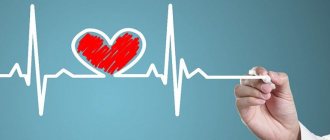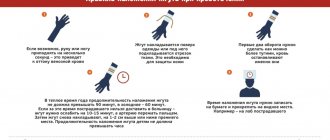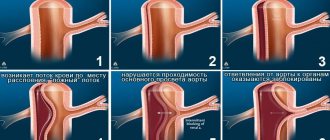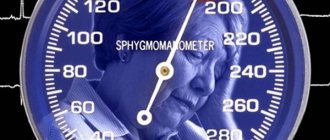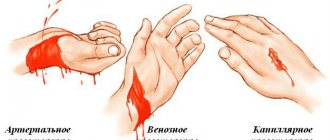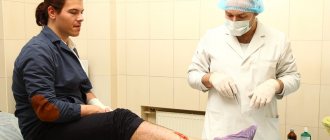If a person has persistently high blood pressure, but does not receive adequate treatment, he may develop a hypertensive crisis. The causes of a hypertensive crisis can be:
- complete refusal of treatment or violation of the therapeutic regimen;
- consumption of alcoholic beverages and drugs;
- glomerulonephritis in the acute stage;
- some tumors are benign and/or malignant;
- preeclampsia;
- injuries, surgical interventions.
It is also customary to distinguish between minor provoking factors:
- autumn and/or winter period of the year;
- errors in the diet (abuse of salty foods, for example), violation of the drinking regime;
- smoking, etc.
At CELT you can consult a cardiologist.
- Initial consultation – 3,500
- Repeated consultation – 2,300
Make an appointment
How to recognize the beginning of a crisis
The condition in question is classified as critical and poses a danger to human life. The symptoms of a hypertensive crisis are quite pronounced, and they certainly cannot be ignored:
- acute chest pain;
- intense headache, accompanied by blurred vision (“the eyes float and ripple”);
- feeling of “fear of death”;
- severe shortness of breath, which is accompanied by nausea (vomiting may occur, but this is rare);
- convulsive syndrome;
- bleeding from the nasal passages.
Please note: medicine knows of cases when the listed symptoms of a hypertensive crisis are mild. In this case, diagnosing the pathological condition is difficult.
A hypertensive crisis may be accompanied by signs of rapidly developing complications. For example, acute “spread” pain in the chest, which constricts the throat, causing shortness of breath, often indicates the progression of myocardial infarction, and a sharp pain in the head, throbbing and unbearable, indicates a stroke.
An important point in determining the onset of a hypertensive crisis is blood pressure control. If it has risen to 180/110 mm Hg or higher, then a repeat measurement should be taken after 5 minutes. If the initial indicators are confirmed, it is necessary to urgently call an ambulance - high blood pressure clearly indicates the beginning of a crisis.
Blood pressure problems are easy to miss
I had to go to the doctor and was diagnosed with hypertension. The doctor prescribed pills to lower blood pressure. Everyone accepted what he said. And the doctor also warned that hypertensive patients have exacerbations - crises. He told me what to do in such a situation.
And one day such a crisis happened. Right away I didn’t even understand what was happening. My daughter had problems. Of course, I was worried about her, I didn’t sleep well for a couple of nights. My heart started to hurt, but somehow I got distracted and forgot to measure my blood pressure and take the pills - I had no time for it. And then suddenly my head felt as if my head was being squeezed, everything swam before my eyes. It’s good that I managed to call my daughter and tell her that I felt bad. I only remember that my lips were numb and it was hard to speak. When she arrived, I was already unconscious. At the hospital, the doctor said that it was a hypertensive crisis.
First aid for hypertensive crisis
Of course, professionals can professionally and competently help a person whose condition is progressing, but everyone also needs to know the rules of first aid in a critical situation. In a hypertensive crisis, it is as follows:
- The patient is given a lying position so that the head and chest are slightly elevated - this will provoke the outflow of blood from the upper body and make breathing easier.
- If hypertension was previously diagnosed and the doctor has already made prescriptions, you need to take the drug in the prescribed dosage - a decrease in blood pressure of a maximum of 30 mm Hg per hour is allowed.
- The patient must take any sedative - it can be validol or valocordin.
Please note: you cannot shake, transport, lift or turn the patient over - in case of a hypertensive crisis, complete rest is indicated for him.
All of the above measures should be carried out after the ambulance team has been called. As a rule, such patients are immediately admitted to a hospital, and already in the medical institution, doctors carry out all the necessary examinations, make appointments, and often everything begins with placing the patient in the intensive care unit. Treatment is carried out as follows:
- If a hypertensive crisis occurs without complications, the patient is prescribed oral antihypertensive drugs that can gradually reduce blood pressure. The drugs are used with caution because they can cause a sharp drop in blood pressure.
- After the patient’s condition is stabilized, he undergoes a full examination and finds out which organs were negatively affected during the crisis. The patient is prescribed a course of treatment on an individual basis.
- For several days after a hypertensive crisis, the patient must still remain in the hospital. Doctors monitor his condition, regularly measure his blood pressure, and gradually return to normal physical activity.
If the request for qualified medical help took place on time, the patient will be prescribed outpatient treatment. As a rule, it consists of regular use of antihypertensive (pressure-lowering) medications, control of blood pressure and gradually increasing physical activity.
Specialized sanatorium-resort treatment also has a good effect, which helps restore health and stabilize the functioning of the heart and blood vessels. An integrated approach to the treatment of the condition in question is the key to a favorable prognosis.
Modern approaches to the rehabilitation of patients with vestibuloatactic disorders
Dizziness is one of the most common complaints of patients when visiting doctors of various specialties. There may be hundreds of diseases and conditions in the differential range of causes of dizziness. At the same time, dizziness is just a subjective sensation of movement of the surrounding space around one’s own body or body in space [4].
Quite often, patients call dizziness and interpret as “dizziness” a condition characterized, first of all, by instability, imbalance, and coordination of movements. These symptoms may be a manifestation of diseases of the nervous system associated with extrapyramidal, cerebellar and other disorders, and are not true dizziness [7].
In some cases, patients refer to dizziness as a feeling of “lightheadedness,” emptiness, impending loss of consciousness, “heaviness in the head,” or, conversely, “extraordinary lightness.” These complaints are characteristic of a lipothymic state and are combined with vegetative-visceral manifestations: pallor of the skin, palpitations, nausea, darkening of the eyes, hyperhidrosis. Similar conditions are observed in cardiac pathology, other cardiovascular diseases, diabetes mellitus with its inherent secondary peripheral autonomic failure, manifested by orthostatic hypotension and postural tachycardia syndrome, also with hypovolemia, metabolic disorders [1, 2, 6].
Another variant of complaints defined by patients as dizziness is a feeling of heaviness “inside the head,” “internal dizziness,” a state similar to intoxication. It is most characteristic of psychogenic dizziness, observed in neuroses and depression. According to T. Brandt, psychogenic dizziness is the second most common cause of dizziness in patients who seek help from specialists - otoneurologists [2]. Dizziness, which develops in connection with mental disorders, is often characterized by the vagueness of the patient’s complaints, as well as a complex of various sensations (visual, auditory, etc.). Such dizziness is not similar to any of the conditions (vestibular dizziness, fainting) and, as a rule, does not occur in attacks, but bothers the patient for many months and years [5, 8].
According to the traditional classification, dizziness is divided into vestibular (true, systemic), associated with damage to the vestibular analyzer, and non-vestibular (non-systemic), which occurs outside the vestibular apparatus. In turn, vestibular vertigo is divided into three groups: peripheral (affecting the labyrinth), intermediate (occurs in the vestibular nerve) and central (occurs in the central nervous system).
The most common causes of central vertigo include vascular disorders (acute ischemia in the brain stem (stroke, transient ischemic attack), chronic cerebral ischemia, whiplash injury of the cervical spine, trauma and brain tumor.
The most common causes of peripheral vertigo include benign paroxysmal positional vertigo, Meniere's disease, vestibular migraine, labyrinthitis, head trauma (temporal bone pyramid fracture), and labyrinthine fistula.
Therefore, differential diagnosis of the causes of dizziness requires an integrated approach with the participation of doctors of various specialties: neurologists, cardiologists, otorhinolaryngologists, psychiatrists, angiosurgeons, etc. Despite the emergence of new technical capabilities for assessing the function of the vestibular system, the basis for the differential diagnosis of the causes of dizziness still lies in a thorough analysis complaints, study of the medical history, clinical and neurological examination of the patient. Diagnostic difficulties may arise due to insufficient competence of a specialist in matters of dizziness, especially in diseases of the peripheral vestibular apparatus and mental disorders.
Very often, in typical clinical practice, the role of changes in the cervical spine, detected during X-ray examination in most elderly and senile people, and the results of ultrasound examination of the main arteries of the head (vertebral arteries) are overestimated. An erroneous diagnosis of “hypertensive cerebral crisis”, “hypertensive crisis” complicated by dizziness associated with discirculation in the vertebrobasilar system, etc. is made [4, 9].
As clinical experience shows, the use of expensive instrumental examination methods (MRI/CT of the brain, electronystagmography, computer posturography, etc.) is necessary only in some patients. Whereas in 2/3 of patients, with a high degree of probability, the correct diagnosis can be made on the basis of complaints, medical history, data from a somatic, neurological and otoneurological examination.
Treatment of dizziness should first of all be aimed at eliminating the cause that caused its development. This is of particular importance in the development of dizziness during cerebral stroke, which, as is known, is just a syndrome, a manifestation of the underlying disease (arterial hypertension (AH), atherosclerosis, diabetes mellitus, etc.). Thus, for dizziness in patients with hypertension, treatment is based on the treatment of the underlying disease, while, of course, normalization of blood pressure is not able to eliminate dizziness in most cases. At the same time, improvement in well-being, disappearance or weakening of such an unpleasant sensation as dizziness, contributes to a stricter adherence of patients to taking antihypertensive drugs and, as a result, normalization of blood pressure. Consequently, pathogenetic and symptomatic treatment becomes of primary importance in the treatment of patients with dizziness.
With the development of cerebral stroke, dizziness is caused by a transient or persistent disruption of the blood supply to the central or peripheral parts of the vestibular system. Moreover, most often dizziness occurs as a result of ischemia of the vestibular nuclei of the brain stem or their connections. During a stroke, dizziness is usually accompanied by other neurological symptoms, such as ataxia, oculomotor disorders, bulbar disorders, paresis, and sensory disorders.
Vestibuloatactic disorders are observed quite often in cerebral stroke. The presence of balance dysfunction increases the possibility of falls, injury to patients, limits their functional activity, reducing the quality of life. In this regard, vestibular rehabilitation, stability training, and improvement of postural control are very important tasks in the rehabilitation treatment of a patient with a stroke.
Complex rehabilitation treatment of vestibuloatactic disorders in stroke includes, in addition to pharmacotherapy, vestibular and oculomotor gymnastics, the use of exercise therapy methods, in particular biomechanotherapy, stabilization training with the effect of biofeedback (BFB), and exercises in an axial loading suit.
After stopping an acute attack of dizziness, which is usually accompanied by violent vegetative symptoms, vestibular exercises are gradually begun, which is a type of therapeutic exercises aimed at accelerating the adaptation of the vestibular system to damage caused by a pathological process, in case of stroke - acute cerebral ischemia. When carrying out this method of rehabilitation treatment, one of the main mechanisms of functional neuroplasticity is used, that is, the ability of various parts of the central nervous system to reorganize due to structural and functional changes - habituation (habituation), which consists in reducing the reflex response to repeated mildly irritating stimuli. The patient is asked to perform a series of exercises that have a mild irritating effect on the vestibular structures. Repeatedly performing them leads to the patient getting used to it and the dizziness subsiding (Table).
A reasonable addition to vestibular gymnastics is the inclusion of stabilometric training based on the principle of biofeedback (BFB) into a comprehensive program of rehabilitation measures. The technique is based on biofeedback, in which the parameters of the projection of the general center of mass onto the plane of support are used as a feedback signal. This method allows the patient to be taught, through special computer “stabilometric games,” to voluntarily move the center of pressure with different amplitudes, speeds, degrees of accuracy and direction of movements without loss of balance. The technical basis is computer modeling, which allows you to display the movement of objects on the screen. Thanks to this technology, an “individual virtual space” is created for a specific patient in accordance with his existing motor dysfunctions, in particular, vestibuloatactic disorders. In this range, the patient makes movements by controlling the screen cursor; to improve the process, additional options are used, for example, stereoscopic glasses [3].
One of the most frequently used trainings is the “Target” program. The patient must, standing on the stabilometric platform in front of the monitor, by moving the body relative to the feet, combine his center of pressure, shown to him on the screen in the form of a cursor, with the target and move the target to a certain area of the screen or maintain the center of pressure (CP) in the center of the target. In this case, the doctor can, by changing the scale, change the patient’s support area, complicating or simplifying the task. At the beginning of training, the movements of a patient with vestibuloatactic disorders, as a rule, are excessive and require the expenditure of a large amount of energy. However, as balance is restored and motor skills emerge, the patient will perform more accurate and timely movements, which will lead to changes in stabilometry characteristics. Also, during classes on the stabilometric platform, other tests are used: “Shooting Range”, “Flower”, “Apple”, the principle of which is similar.
A very effective method in the complex of rehabilitation of patients with vestibuloatactic disorders during stroke is the use of an axial loading suit with a system of load elements, based on the restoration of functional connections due to the flow of afferent information and improving the trophism of tissues under load. The mechanism of action is also associated with limiting the hypermobility of the articular-ligamentous apparatus, a compressive effect on the foot in the form of counteracting its pathological position, and stretching the muscles that help normalize muscle tone.
The medical suit consists of a system of elastic load elements (vest, shorts, knee pads, special shoes), which are distributed in accordance with the topography of the anti-gravity muscles.
Before starting classes in a suit, it is necessary to determine the level of the functional mobility category, i.e. the ability to move (according to the classification of Perry J. et al. 1995). Depending on the level of mobility, there are two options for the lesson program:
- The first is for patients with lower categories of functional mobility when walking (categories 2 and 3), when the patient cannot move without an accompanying person due to severe dizziness and ataxia.
- The second is for patients with higher categories of mobility, when the patient can move without assistance on a straight surface, but requires assistance when walking on uneven surfaces, going up and down stairs (categories 4 and 5).
The most important condition for conducting classes is the use of methods for monitoring the effectiveness of loads, including assessment of saturation and indicators of systemic hemodynamics (BP, heart rate). The course of treatment includes 10–12 sessions.
An important component of the rehabilitation treatment of stroke patients with vestibuloatactic disorders is the organization of care and nursing. Impaired coordination of movements with preserved muscle strength in the limbs can cause loss of the ability to self-care and a decrease in the functional activity of patients.
In order to improve the quality of life of patients with the disorders described above after a stroke, the latest technologies used in care are being introduced today. Proper care is not opposed to treatment, but is organically included in it as an integral part and involves the creation of a favorable everyday and psychological environment at all stages of treatment.
Currently, absorbent products (MoliCare® Premium soft diapers for sedentary patients and MoliCare® Mobile absorbent panties for patients who have retained mobility) are actively used in patients with cerebral stroke who have impaired movement function due to vestibuloatactic disorders, which are necessary not only for impaired functions of the pelvic organs, but also with a decrease in the overall functional activity of patients.
The main requirements for modern special hygiene products for patients with urinary problems (for various reasons: urinary incontinence, inability to urinate) are: the ability to absorb and retain urine for several hours; the ability to keep the surface dry for a long time (so as not to cause skin irritation); anatomical compliance; ease of wearing, comfort, invisibility under clothing; preventing the growth of bacteria and the spread of unpleasant odors. The products of this brand fully comply with the listed requirements, can significantly reduce psycho-emotional tension, increase social activity and, accordingly, the quality of life of the patient, and expands the possibilities of carrying out rehabilitation measures.
At the Neurology Clinic of MONIKI named after. M. F. Vladimirsky examined and comprehensively treated 65 patients in the early recovery period of ischemic stroke in the vertebrobasilar region aged from 45 to 75 years (average age 59.48 ± 8.63 years).
All patients in the study were divided into two groups. The main group included 35 patients (17 men and 18 women) who underwent complex treatment using drug therapy with betahistine (Betaserc), vestibular gymnastics, stabilization training with biofeedback (BF), and exercises in the Regent axial loading suit. The course of treatment consisted of 10–15 sessions. The control group included 30 patients and was comparable to the main group in all respects. Patients in the control group received pharmacotherapy in accordance with the standards for the management of patients with acute cerebrovascular accidents.
At the end of the course of classes in the main group of patients, clinical assessment of the degree of resistance revealed a significant (p 0.05).
Thus, complex rehabilitation treatment, including pharmacotherapy, vestibular gymnastics, stabilization training, and training in an axial loading suit, led to a decrease in the intensity and duration of dizziness, regression of coordination disorders, and an increase in the stability of the vertical posture.
- Abdulina O. V. Parfenov V. A. Vestibular dizziness in emergency neurology // Clinical gerontology. 2005, No. 11, p. 15–18.
- Brandt T. Dieterich M. Strupp M. Dizziness (translated from English). Translation editor M. V. Zamergrad. M. Praktika, 2009, 198 p.
- Kadykov A. S. Chernikova L. A. Shakhparonova N. V. Rehabilitation of neurological patients. M. MEDpress-inform, 2009, 555 p.
- Parfenov V. A. Zamergrad M. V. Melnikov O. A. Dizziness: diagnosis and treatment, common diagnostic errors. Tutorial. M. Medical Information Agency, 2009, 149 p.
- Tabeeva G.R. Vein A.M. Dizziness in psychovegetative syndromes // Consilium Medicum. 2001, vol. 4, no. 15.
- Shtulman D.R. Dizziness and imbalance. In the book. Diseases of the nervous system. Ed. N. N. Yakhno. M. 2005. pp. 125–130.
- Brandt T. Dieterich M. Vertigo and dizziness: common complains. London: Springer, 2008. 208 p.
- Schmid G. Henningsen P. Dieterich M. Sattel H. Lahmann C. Psychotherapy in dizziness: a systematic review // J Neurol Neurosurg Psychiatry. 2011, Jun; 82(6):601–606.
- The Cochrane Library. Issue I. Oxford: Update Software, 2009.
M. V. Romanova
S. V. Kotov, Doctor of Medical Sciences, Professor
E. V. Isakova, Doctor of Medical Sciences, Professor
GBUZ MONIKA named after. M. F. Vladimirsky, Moscow
Contact information for authors for correspondence:
Forecasts for hypertensive crisis
After stopping the hypertensive crisis, patients can live happily and fully - according to statistics, 40% of patients continue to lead an active lifestyle for many years. Most often, death occurs as a result of the rapid development of complications - myocardial infarction, heart failure, stroke, renal failure. Sometimes the death of a patient occurs due to untimely assistance, so you need not only to know the symptoms of a hypertensive crisis, but also to be able to provide first aid to the patient.
Timely seeking help from CELT specialists will help not only prevent an unfavorable outcome, but also return the patient to a full life.
Make an appointment through the application or by calling +7 +7 We work every day:
- Monday—Friday: 8.00—20.00
- Saturday: 8.00–18.00
- Sunday is a day off
The nearest metro and MCC stations to the clinic:
- Highway of Enthusiasts or Perovo
- Partisan
- Enthusiast Highway
Driving directions
Which doctors should you visit during the rehabilitation process?
In severe cases of hypertension, and especially after a crisis, the patient must undergo regular preventive examinations with the following medical specialists:
- Psychotherapist;
- Gynecologist (for the fair sex)4
- Neuropathologist;
- Ophthalmologist;
- Urologist;
- Endocrinologist;
- Surgeon;
- Nephrologist;
- Nutritionist.
Regular examinations are required to identify and timely eliminate factors that provoke the development of a hypertensive crisis and increased blood pressure.
In addition, it is recommended to undergo urine and blood tests, undergo an ultrasound examination, computed tomography or magnetic resonance imaging, to assess the extent of damage to internal organs and systems after an attack.
Stabilization of the emotional background prevents relapses of pressure surges
